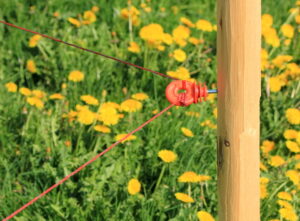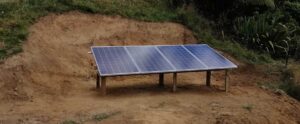TYPES OF ENERGISERS
Electric fence energisers vary in their source of power and their power output. They fall into two groups – battery-powered and mains-powered. Solar-powered systems are increasingly popular and involve the use of a battery-powered unit used in conjunction with a solar panel.
Agri Solar offers a complete line of fence controllers: mains-powered, battery-operated and solar-powered. State-of-the-art electronics and solid-state circuitry are utilised in the designs. All units are tightly enclosed in rugged, watertight ABS cases that won’t rust, corrode or crack, even when subjected to harsh weather and operating conditions.
EARTHING
In practice, most problems that occur with electric fences are caused by poor earthing. In order for the animal to receive a shock, there must be a good current flow from the pulsed output terminal of the energiser to the animal, and back to the earth terminal. Therefore, it is imperative that the earth terminal is well and truly earthed. Never use your waterpipes, windmill, or household earth rod for your electric fence earth, because there is a definite risk of shock under certain conditions.
One of the best systems for adequate earthing consists of a series of galvanised steel posts driven at least 1.5 metres into the ground, and positioned at least 3 metres apart, in a straight line. The posts are to be connected to each other, and to the earth terminal of the energiser, using galvanised or brass nuts and bolts. Alternatively, you could use a length of galvanised water pipe instead of the steel posts, but it is harder to drive in and is more difficult to connect satisfactorily to the earth wire.
SELECTING THE RIGHT ENERGISER
To optimise the performance of your electric fence, it is essential to select an energiser capable of performing well under your prevailing fence conditions and suited to your application. The following factors should be considered when making this decision:
- Is mains power available? It is generally preferable to use mains power when it is available. Mains energisers are easier and more economical to run as there are no batteries to maintain.
- The condition of your fence…A fence that may be subjected to leakages such as heavy weed growth, overhanging foliage, or poor insulation, will require a more powerful energiser to effectively power your fence than under normal conditions.
- The type of animal you wish to control…
The response of different types of animals will vary with the size of the shock. The appropriate shock should be designed to bring about the desired reaction from the animal that you wish to control. Often the coat of the animal provides effective insulation in which case a higher voltage shock is necessary to overcome the insulation (eg. sheep). “Educated” animals do not require as large a shock as do animals encountering electric fencing for the first time.
FENCE INSULATION
It is essential that your electric fence is properly insulated along its full length. Insulators are designed to take all wire types, tape and rope on wood, steel and fibreglass posts. The Agri Solar range of insulators offers you the most versatile line.
Plastic insulators are easy to use, offer optimum insulation, and are relatively inexpensive. Good quality plastic insulators such as those manufactured by Agri Solar are U.V. resistant and are made from virgin polyethylene. Therefore, they offer a long service life.
FENCE CONSTRUCTION
STRIP GRAZING
Fences for strip grazing come in many forms. Most commonly they are fully portable and constructed of a single wire. All the components of this fence are easily installed and can be moved by hand quite efficiently.
FENCE LAYOUT
The overall layout of your electric fence system deserves careful planning because the amount of care taken at the planning stage will determine the amount of time you have to put into checking and maintaining your fence in the future.
LENGTH OF RUNS
It is better to have several short runs of fence leading out from the energiser, rather than one long run.
MAINTENANCE AND TROUBLESHOOTING
To achieve optimal performance from your electric fence, it is essential to ensure the fence is properly maintained. A voltmeter or a fault finder are essentials tools in carrying out maintenance and troubleshooting procedures. A regular maintenance programme should include the following:
- Clear your fence line of grass and weed growth
- Clear away broken branches, or other debris that may have fallen on the fence
- Check for slack or broken wires
- Battery maintenance for solar or battery-powered energisers
- Testing for voltage drops along the fence to identify short circuits. Walking the fence line with a portable radio tuned off the station and on high volume is a quick and easy way to locate any electrical leakage (you hear the pulse).
TECHNICAL TERMS
The mathematical formula for a Joule is as follows:
Joule = Watts x Time
Watt = Volts x Ampere
Ampere = Volts / Ohms
Volt = Unit of electrical current which causes current (amps) to flow
A Joule can, therefore, be defined as follows:
Joule = Volt x Ampere x Time (duration of the pulse)
or
Volt x Volt x Time / Ohm
This means that the Joule rating of an energiser can be increased by:
- Increasing the voltage produced
- Increasing the current
- Increasing the duration of the pulse.
Watts as a measure of performance seems to be a more accurate way of measuring the performance as it would exclude the time (pulse width).

